As the most intuitive window to experience automotive intelligent technology, intelligent cockpit is steadily moving towards the deep end of “intelligence”, and automakers have worked to deploy intelligent cockpit functions they regard as the differentiated selling points of their vehicle models.
In 2023, OEMs released a number of innovative concept models and new models for sale, especially models of emerging brands such as Xpeng, ZEEKR, Galaxy, LUXEED, NEVO, Avatr and Jiyue. New technologies, new scenarios and new modes including diversified displays, new UIs, comfortable intelligent seats, panoramic sound effects, ambient lights, and intelligent surfaces spring up.
Display and interior design are deeply integrated to emphasize emotional resonance with users.
Automotive display, as the intelligent cockpit component users can perceive most easily, has become an important means for automakers to offer a differentiated experience for users. In 2023, cockpit display design shows the trend of multi-screen, large screen, diversification and technology.
First, the number of models with large integrated displays is increasing. In recent years, Ford, Lincoln, Cadillac, ARCFOX, IM, Roewe, Jiyue, Geely Galaxy and many other auto brands have launched models with integrated displays which are tending to be bigger, for example, Geely Galaxy E8 is equipped with a 45-inch 8K integrated display, Jiyue 01 with a 35.6-inch 6K integrated display, Cadillac LYRIQ with a 33-inch integrated display, Buick E5 with a 30-inch 6K integrated curved display, and Ford EVOS with a 27-inch 4K integrated display.
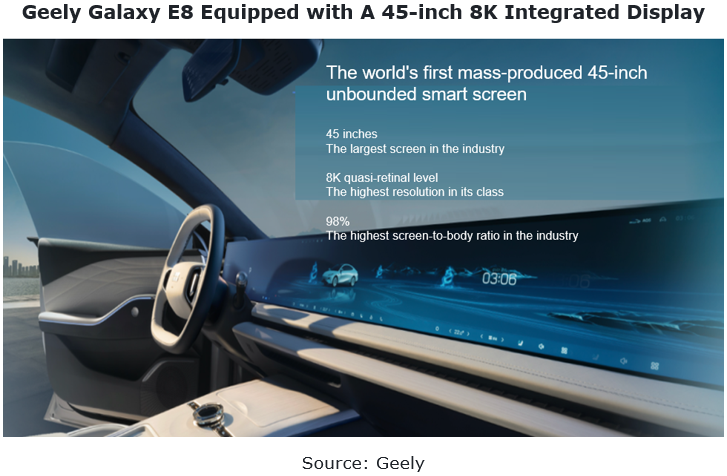
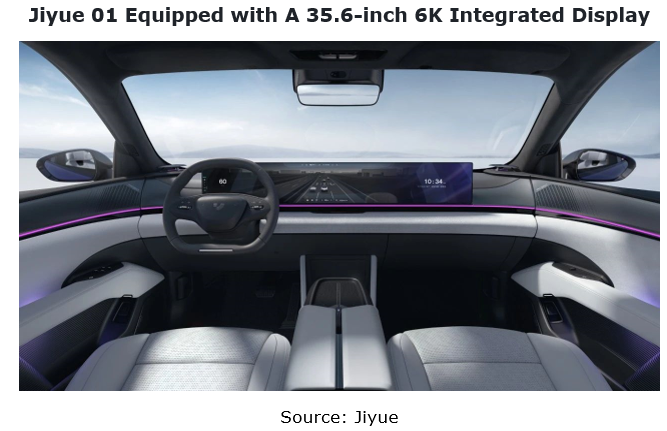
Second, the conventional cluster screen is replaced by the design and display layout. In the trend for extremely simplified design, there is a design mode in which the cluster screen is replaced. On the market Tesla Model 3 and Model Y are the first models without clusters. Their cluster functions are mainly concentrated on the left area of the center console display to expand the visible field of view, improve user experience, and embody intelligence.
In addition to Tesla, many models launched in 2023 adopt the center console + HUD design without common clusters. For example, Li Auto’s L Series models, Changan NEVO A07, Deepal S7, Geely Livan 7, and HiPhi Z all have HUDs without clusters. As intelligence level gets higher and display technology matures and advances, display and interior will be further integrated, and cluster screens of more models will be cancelled or replaced.
Deepal S7 adopts the embracing interior design like a luxury yacht, highlighting luxury and comfort. Equipped with a 15.6-inch intelligent steering screen and AR-HUD but without cluster, it focuses the front view of the driver upward to improve safety by deeply integrating intelligent driving and vehicle systems.
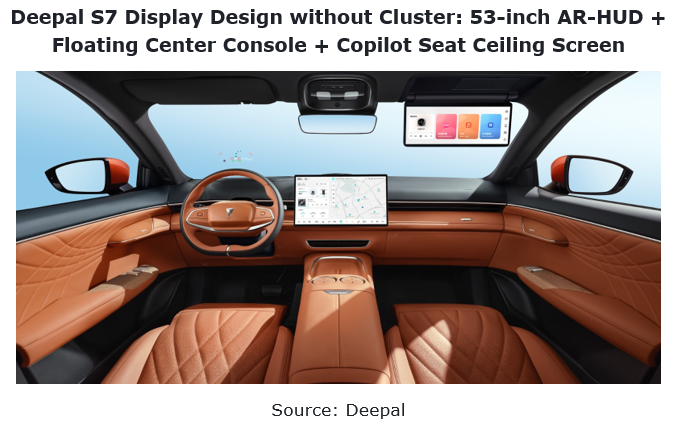
Changan NEVO A07 adopts an unconventional design style of "Emotional Island Floating Interior Space". The common cluster at the driver’s seat is canceled and replaced by a 50-inch AR HUD and a floating center console screen.

As display and interior tend to be integrated and technology matures, display design concepts such as holographic display, projection, invisible screens and non-screen design have appeared.
In 2023, BMW released i Vision Dee, a vision vehicle that enables digital emotional interaction, demonstrating BMW’s vision for the future digital experience inside and outside the car. There are no physical buttons in the car. By using Shy Tech, the HUD system replaces the conventional LCD to create a mixed reality interactive interface. Using shy-tech sensors on the instrument panel and the five-level touch slider projected on the center console, drivers can determine the content and area displayed on the HUD system (which can span the entire windshield).

In addition to conventional cluster, center console and copilot seat display, there are a variety of diversified display products such as copilot seat ceiling screen, center console ceiling screen, lifting screen, sliding screen, privacy screen, and light field screen.
Based on visual design upgrade, exploration of UI gets deeper in terms of 3D HMI and custom settings.
As automotive display technology continues to mature, automotive human-machine interfaces (HMI) are being upgraded, and elements such as zero-level interaction, card-style design and flatness have been widely used. With the enrichment of smart car functions and contents, the future interface interaction is becoming more concise, 3D intuitive, and personalized.
As 3D HMI penetrates into the automotive field, the application of 3D HMI is no longer limited to 3D virtual assistants and 3D car models, and it finds broader application in 3D AR-HUD, 3D map navigation and driving assistance scenarios, seamless 3D scene functional transition (one shot), and 3D immersive scene space.
3D HMI solutions gradually penetrate from some functions to the system desktop and even the all-scenario function solution design. The intuitive and three-dimensional interactive experience not only improves the convenience and safety of the driver's operation, but also provides high-quality entertainment experiences.
In 2023, Flyme Auto, an IVI system jointly built by Meizu and Geely, was equipped with a 3D car model desktop. It can realize seamless transition between different scenes, break through the application boundary, reduce the sense of separation between the desktop and the application, present the environmental elements outside the car in real time and live, and provide common settings according to different scenarios, thus enhancing user experiences from vision to interaction to comprehensive live functions.
Based on 3D engine rendering, the desktop of Flyme Auto is designed with 'Ruran Engine', which shows the passage of 24 hours a day through real-time rendering and integrates the weather system into it, so that users can immediately feel the unbounded experience of breaking the boundaries between digital world and reality. In addition, its air conditioning and charging interfaces are designed with 3D particle dynamic effects to enhance the emotional value of the product, which is vivid.
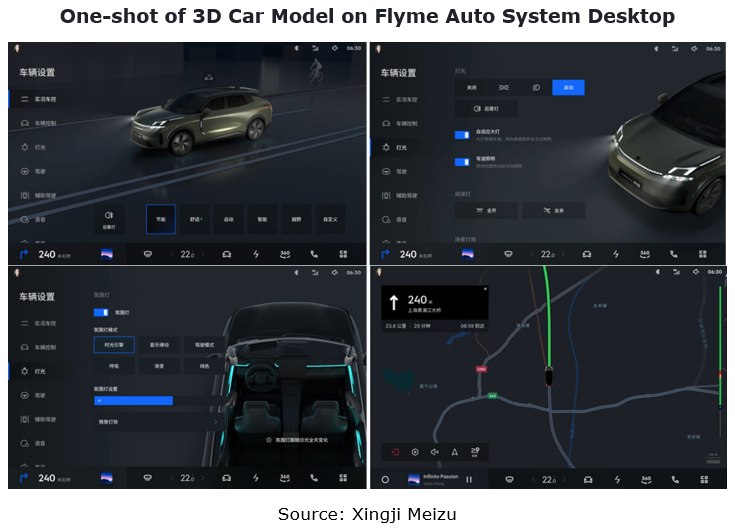
To meet personalized needs, the IVI UI also keeps expanding. At present, multiple models offer customizable options in IVI UI settings, evolving from originally a few customizable options to the personalized settings that are customizable on multiple function pages.
In October 2023, Xpeng released Xpeng X9, its first MPV equipped with a new smart cockpit XOS and a multi-task architecture which supports independent operation of multiple tasks. The new XDock supports custom editing, places frequently-used functions required in different seasons/scenarios in the Dock bar to achieve zero-level interaction between commonly used functions.
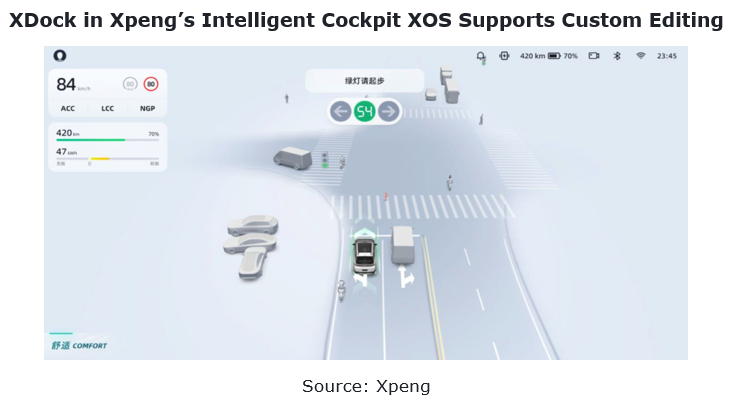
In 2023, the IVI desktop of Lynk & Co 09 equipped with LYNK OS N features super customization. Users can define desktop cards, first-level menus of vehicle settings, vehicle control pages and Dock bar cards as they like.
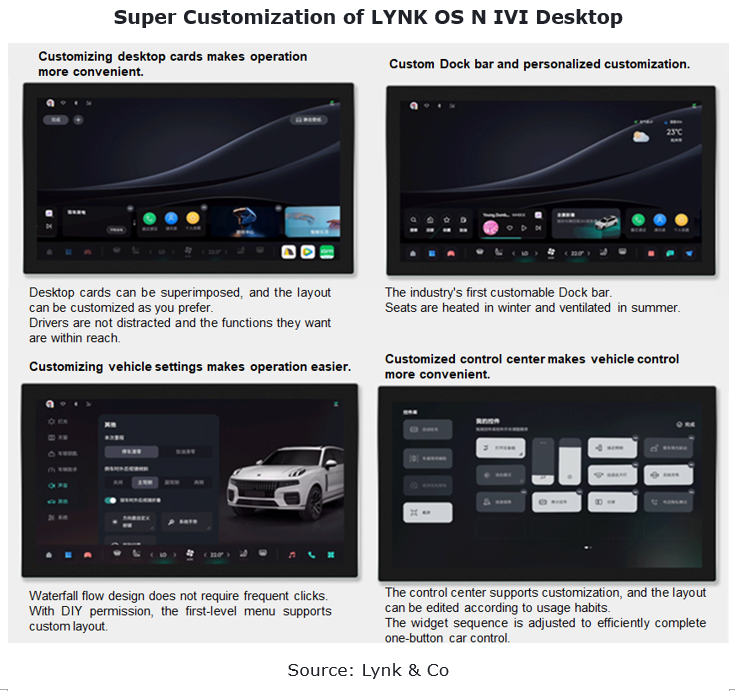
In addition, the IVI UI has begun to resemble that UI of mobile phones and tablet PCs. For example, split screen is used in multiple models, reducing user learning costs and improving user experience.
The design trend of deep integration between IVI and terminal devices such as mobile phones
In recent years, in order to improve the user experience, the deep integration between mobile phones and IVI has become one of the inevitable development trends. In the era of electric intelligence, the deep integration between the automotive industry and the consumer electronics industry is conducive to realizing the close interaction between IVI and mobile phone software technology, promoting the construction of cross-border user ecosystems, and truly providing users with more convenient and intelligent experiences.
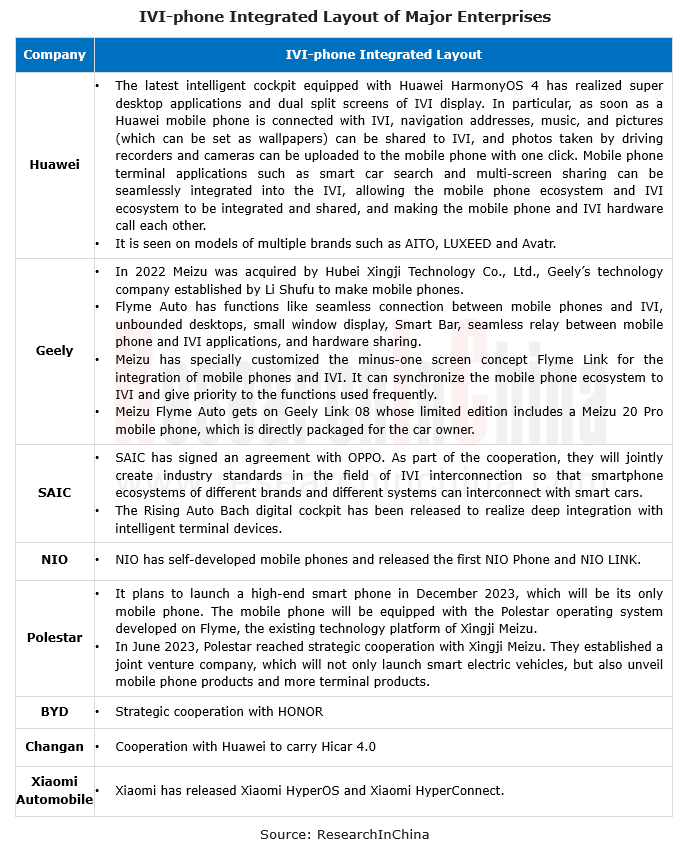
In November 2023, Chery and Huawei released their cooperative model LUXEED S7 whose cockpit is equipped with Huawei's new HarmonyOS 4.0. This intelligent cockpit brings a more powerful super desktop, and supports more applications to land on the car and call each other, greatly expanding its application scenarios.
Based on HarmonyOS 4.0, the intelligent cockpit of LUXEED S7 not only enables the most common entertainment connection, but also makes audio and video calls with Huawei mobile phones, tablet PCs, etc. It also supports the rapid transmission of navigation and entertainment information between devices, and easily controls a number of connected devices at home through comprehensive car-home interconnection capabilities, becoming a truly brand-new mobile smart device besides mobile phones and tablet PCs.
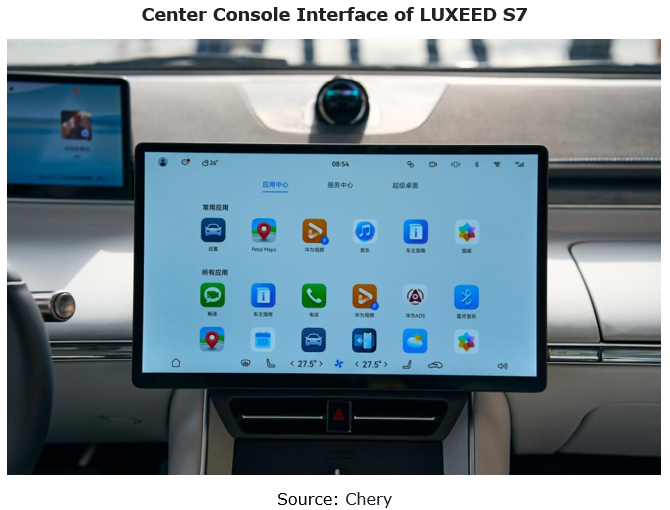
In October 2023, Xiaomi released the Xiaomi HyperOS, which aims to create a people-centric "ecological" operating system covering humans, cars and homes. Also Xiaomi has developed Xiaomi HyperConnect to make devices connect efficiently and cooperate excellently. With HyperOS, devices can be networked dynamically in real time.
Xiaomi HyperConnect connects the entire Xiaomi HyperOS ecosystem. Each device is like a tentacle that perceives the world, and they are connected together to form a huge network to ultimately forge a smart world of "human-car-home ecosystem". Users can see the devices in the control center, make the devices cooperate with each other without connection, and call the hardware capabilities of other devices in real time. For example, the menu in the upper right corner of the Xiaomi mobile phone has a separate control module designed for the car. The Xiaomi mobile phone can connect to Car WiFi. When the car owner is about to arrive home, his/her family can check the specific arrival information via the Xiaomi TV. The car owner can turn on the in-car camera and make video calls with his/her mobile phone. Xiaomi HyperOS features clear picture quality and extremely low latency, and also supports users to copy text, pictures, files, etc. across devices.
In the future, smart car user experience design will be further integrated with other platforms and devices. Users can seamlessly connect smart phones, smart homes and other devices with smart cars to achieve cross-platform integrated control and interaction. This design trend can provide more consistent and convenient user experiences. The integration of cross-terminal devices allows for the layout of home-car-office integration and other integrated scenarios.
China Automotive Multimodal Interaction Development Research Report, 2024
Multimodal interaction research: AI foundation models deeply integrate into the cockpit, helping perceptual intelligence evolve into cognitive intelligence
China Automotive Multimodal Interaction Dev...
Automotive Vision Industry Report, 2024
Automotive Vision Research: 90 million cameras are installed annually, and vision-only solutions lower the threshold for intelligent driving. The cameras installed in new vehicles in China will hit 90...
Automotive Millimeter-wave (MMW) Radar Industry Report, 2024
Radar research: the pace of mass-producing 4D imaging radars quickens, and the rise of domestic suppliers speeds up.
At present, high-level intelligent driving systems represented by urban NOA are fa...
Chinese Independent OEMs’ ADAS and Autonomous Driving Report, 2024
OEM ADAS research: adjust structure, integrate teams, and compete in D2D, all for a leadership in intelligent driving
In recent years, China's intelligent driving market has experienced escala...
Research Report on Overseas Layout of Chinese Passenger Car OEMs and Supply Chain Companies, 2024
Research on overseas layout of OEMs: There are sharp differences among regions. The average unit price of exports to Europe is 3.7 times that to Southeast Asia.
The Research Report on Overseas Layou...
In-vehicle Payment and ETC Market Research Report, 2024
Research on in-vehicle payment and ETC: analysis on three major application scenarios of in-vehicle payment
In-vehicle payment refers to users selecting and purchasing goods or services in the car an...
Automotive Audio System Industry Report, 2024
Automotive audio systems in 2024: intensified stacking, and involution on number of hardware and software tuning
Sales of vehicle models equipped with more than 8 speakers have made stea...
China Passenger Car Highway & Urban NOA (Navigate on Autopilot) Research Report, 2024
NOA industry research: seven trends in the development of passenger car NOA
In recent years, the development path of autonomous driving technology has gradually become clear, and the industry is acce...
Automotive Cloud Service Platform Industry Report, 2024
Automotive cloud services: AI foundation model and NOA expand cloud demand, deep integration of cloud platform tool chainIn 2024, as the penetration rate of intelligent connected vehicles continues to...
OEMs’ Passenger Car Model Planning Research Report, 2024-2025
Model Planning Research in 2025: SUVs dominate the new lineup, and hybrid technology becomes the new focus of OEMs
OEMs’ Passenger Car Model Planning Research Report, 2024-2025 focuses on the medium ...
Passenger Car Intelligent Chassis Controller and Chassis Domain Controller Research Report, 2024
Chassis controller research: More advanced chassis functions are available in cars, dozens of financing cases occur in one year, and chassis intelligence has a bright future. The report combs th...
New Energy Vehicle Thermal Management System Market Research Report, 2024
xEV thermal management research: develop towards multi-port valve + heat pump + liquid cooling integrated thermal management systems.
The thermal management system of new energy vehicles evolves fro...
New Energy Vehicle Electric Drive and Power Domain industry Report, 2024
OEMs lead the integrated development of "3 + 3 + X platform", and the self-production rate continues to increase
The electric drive system is developing around technical directions of high integratio...
Global and China Automotive Smart Glass Research Report, 2024
Research on automotive smart glass: How does glass intelligence evolve
ResearchInChina has released the Automotive Smart Glass Research Report 2024. The report details the latest advances in di...
Passenger Car Brake-by-Wire and AEB Market Research Report, 2024
1. EHB penetration rate exceeded 40% in 2024H1 and is expected to overshoot 50% within the yearIn 2024H1, the installations of electro-hydraulic brake (EHB) approached 4 million units, a year-on-year ...
Autonomous Driving Data Closed Loop Research Report, 2024
Data closed loop research: as intelligent driving evolves from data-driven to cognition-driven, what changes are needed for data loop?
As software 2.0 and end-to-end technology are introduced into a...
Research Report on Intelligent Vehicle E/E Architectures (EEA) and Their Impact on Supply Chain in 2024
E/E Architecture (EEA) research: Advanced EEAs have become a cost-reducing tool and brought about deep reconstruction of the supply chain
The central/quasi-central + zonal architecture has become a w...
Automotive Digital Power Supply and Chip Industry Report, 2024
Research on automotive digital power supply: looking at the digital evolution of automotive power supply from the power supply side, power distribution side, and power consumption side
This report fo...